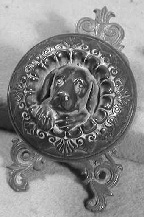In 1999 I wrote Antique Hardware Price Guide, and it features the photos and prices realized of items sold through my first 10 auctions that had begun in 1995. Back then, the antiques business was driven by an interesting economic variable I like to call "perceived supply", which means that the true amount of available goods is a blind number, so even limited demand can drive prices to very high levels. This dynamic is especially evident in a market such as antiques where having "the only one", or owning "one of only 3 or 4 known examples" is every collectors' objective.
Back in the late 20th Century the antiques market was very active, and perceived supply was pushing prices up and keeping them strong. My auctions became famous when we sold an "extremely rare" doggie doorknob for $3765 in 1996, and that story still has legs, with people talking about it 12 years and more than 50 auctions later.
About that time, however, the Internet emerged, causing collectors to come to grips with the virtual reality of Cyber-Econ 101: a worldwide market, plus technology, brings out the real supply number, and with demand remaining pretty much level, prices can—and did—fall sharply.
Example: that famous doggie doorknob is now listed often on Internet auctions, and with way too few new doorknob collectors emerging, so this once-revered hardware icon sells today for about $1,000.
At the same time, the Internet has opened a quick and easy selling venue that brings truly rare things. So where supply remains truly limited, even slight demand pressures can cause prices to rise and prompting winners to yell "wow, I won!", and back-bidders to grouse that "Some fool paid way too much..."
Now, this long introduction is actually a segway into the topic at hand, which is what to do if you a)want to cash in your collection and spend the money, or b) to leave instructions for your family about how to deal with all those objects in the basement after you are gone?
My short answer for the best selling strategy is to use an Internet auction. Auctions allow you to sell the largest quantity of items at one time, and the Internet gives you maximum buyer exposure.
My short answer for the worst selling strategy is to call in collector friends, thinking they will pay "market prices" At best they will offer wholesale values for the choice items and leave you with a pile of stuff nobody wants. Quite likely you will also give away a few rare and wonderful pieces that would have brought big money were they offered in a market where serious collectors could compete.
Please note that both previous paragraphs emphasize the phrase "short answer". Just how you select the sales venue best for you requires a lot of thought, and then a lot of work. This is why many collectors balk at the daunting project of sorting through years of accumulation and just leave the collection, and the hard decisions, to others.
Perhaps I will share more auction and antiques experiences in future articles, but for now, I'll leave you with a few thoughts.
1. The 80/20 theory is absolutely valid. Select the best 20% of your collection. That will represent 80% of the collection's total value. Sell off the remaining 80% however you can. You will end up with a nice amount of money and you will never miss what you sold.
2. After 6 months, do the 80/20 exercise on the 20% you kept. Another round of sales will net you strong money and you'll still have the very best and most valuable part of your collection to enjoy. This remaining top 5% of your original pile is now ready for presentation as a great auction that you can organize and enjoy, or it becomes a very manageable project for your heirs.
3. Do something about the shrinking collecting market. Write an article and send it to trade papers and collector magazines. If everyone thinks certain items are worth nothing, how will you sell your collection if there is no buying interest? If new collectors are not shown what and how to buy at the $10 and $20 level, why would they even consider buying at the $100 or $1,000 level?
4. Almost every collecting category features at least one example that has sold for more than $10,000. Old things of quality appeal to a very large market, but everyone's first question is "what's it worth?". So help people figure out that answer or your "treasures" will remain only as valuable as toadstools: coveted by the frogs and elves, but just about worthless to most everyone else.
Weber Wilson is an antiques dealer and manager of LLD Specialty Sales, LLC, Portsmouth, R.I.
Tags:
How the internet changed the value of a doggie doorknob from "very rare" to "just wonderful"
September 18, 2008 - Construction Design & Engineering
.png)








